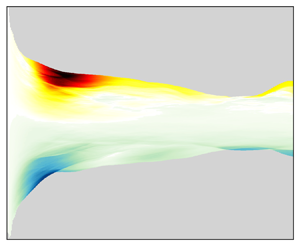Crossref Citations
This article has been cited by the following publications. This list is generated based on data provided by
Crossref.
Chen, Tao
and
Liu, Tianshu
2022.
Near-wall Taylor-series expansion solution for compressible Navier–Stokes–Fourier system.
AIP Advances,
Vol. 12,
Issue. 1,
Yu, Ming
Liu, Peng Xin
Fu, Ya Lu
Tang, Zhi Gong
and
Yuan, Xian Xu
2022.
Wall shear stress, pressure and heat flux fluctuations in compressible wall-bounded turbulence. II. Spectra, correlation and nonlinear interactions.
Physics of Fluids,
Vol. 34,
Issue. 6,
Liu, Ling
Li, Jing
and
Liao, Shijun
2022.
Explicit series solutions for supersonic flat-plate boundary layer flows.
Physics of Fluids,
Vol. 34,
Issue. 7,
Xu, Dehao
Wang, Jianchun
Yu, Changping
Li, Xinliang
and
Chen, Shiyi
2022.
Contribution of flow topology to the kinetic energy flux in hypersonic turbulent boundary layer.
Physics of Fluids,
Vol. 34,
Issue. 4,
Cogo, Michele
Salvadore, Francesco
Picano, Francesco
and
Bernardini, Matteo
2022.
Direct numerical simulation of supersonic and hypersonic turbulent boundary layers at moderate-high Reynolds numbers and isothermal wall condition.
Journal of Fluid Mechanics,
Vol. 945,
Issue. ,
Xu, Dehao
Wang, Jianchun
Yu, Changping
Li, Xinliang
and
Chen, Shiyi
2022.
Effect of compressibility on the small-scale structures in hypersonic turbulent boundary layer.
Physics of Fluids,
Vol. 34,
Issue. 5,
Ma, Rui
Gao, Zheng-hong
Lu, Lian-shan
and
Chen, Shu-sheng
2022.
Skin-friction drag reduction by local porous uniform blowing in spatially developing compressible turbulent boundary layers.
Physics of Fluids,
Vol. 34,
Issue. 12,
Chen, Yuandong
Wang, Xiaoning
Duan, Lishu
and
Wang, Jianchun
2022.
Effect of heat source on kinetic energy transfer in compressible homogeneous shear turbulence.
Physics of Fluids,
Vol. 34,
Issue. 12,
Xu, Dehao
Wang, Jianchun
and
Chen, Shiyi
2022.
Skin-friction and heat-transfer decompositions in hypersonic transitional and turbulent boundary layers.
Journal of Fluid Mechanics,
Vol. 941,
Issue. ,
Zhang, Peng-Jun-Yi
Wan, Zhen-Hua
Liu, Nan-Sheng
Sun, De-Jun
and
Lu, Xi-Yun
2022.
Wall-cooling effects on pressure fluctuations in compressible turbulent boundary layers from subsonic to hypersonic regimes.
Journal of Fluid Mechanics,
Vol. 946,
Issue. ,
2023.
The effect of spanwise wall oscillation on spatially developing compressible transitional boundary layers.
Physics of Fluids,
Vol. 35,
Issue. 7,
Bai, Yuping
Yan, Peiwen
Yu, Yifei
Zhao, Quanbin
Chong, Daotong
and
Yan, Junjie
2023.
On the origin of spanwise vortex deformations during the secondary instability stage in compressible mixing layers.
Physics of Fluids,
Vol. 35,
Issue. 3,
Sandberg, Richard D.
2023.
Resolvent-based analysis of hypersonic turbulent boundary layers with/without wall cooling.
Physics of Fluids,
Vol. 35,
Issue. 4,
Camillo, Giannino Ponchio
Wagner, Alexander
Toki, Takahiko
and
Scalo, Carlo
2023.
Combined Experimental and Numerical Investigation of a Hypersonic Turbulent Boundary Layer by Means of FLDI and Large-Eddy Simulations.
Aerospace,
Vol. 10,
Issue. 6,
p.
570.
2023.
On the origin of streamwise vortices in braid regions for compressible mixing layers.
Physics of Fluids,
Vol. 35,
Issue. 7,
Liu, PengXin
Li, JunYang
Su, HongMin
Sun, Dong
Yu, Ming
and
Yuan, XianXu
2023.
Wall temperature effects on wall heat flux in high-enthalpy turbulent boundary layers.
Aerospace Science and Technology,
Vol. 140,
Issue. ,
p.
108432.
Zhang, Peng-Jun-Yi
Wan, Zhen-Hua
Dong, Si-Wei
Liu, Nan-Sheng
Sun, De-Jun
and
Lu, Xi-Yun
2023.
Conditional analysis on extreme wall shear stress and heat flux events in compressible turbulent boundary layers.
Journal of Fluid Mechanics,
Vol. 974,
Issue. ,
Zhang, Duo
Yuan, Xueqiang
Liu, Shijie
Zhu, Ke
and
Liu, Weidong
2023.
Experimental study of wall temperature effect on shock wave/turbulent boundary layer interaction in hypersonic aircraft.
Energy,
Vol. 263,
Issue. ,
p.
125753.
Pal, Ribhu
Roy, Arnab
and
Halder, Pabitra
2023.
Numerical studies of shock–vortex interaction over a wedge during shock-wave diffraction—A new approach.
Physics of Fluids,
Vol. 35,
Issue. 10,
Xu, Dehao
Wang, Jianchun
and
Chen, Shiyi
2023.
Reynolds number and wall cooling effects on correlations between the thermodynamic variables in hypersonic turbulent boundary layers.
Journal of Fluid Mechanics,
Vol. 965,
Issue. ,




